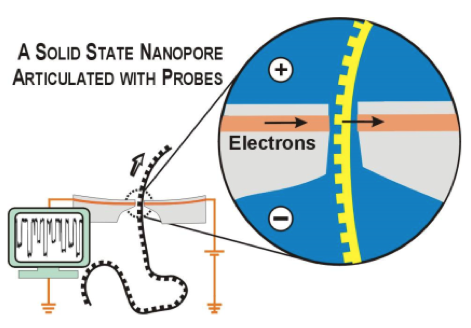Disk drives and flash are already pushing the limits of nanotechnology to increase density. But what if we went with encoding data directly into molecules? Does a petabyte per cc sound interesting?
In Advances in Macromolecular Data Storage, Masud Mansuripur, a professor in the College of Optical Sciences at the University of Arizona, proposes a storage system with read/write bandwidth competitive with SSDs and capable of staggering density. Every so often someone announces they’ve encoded data into, say, DNA as a lab demo, but Prof. Mansuripur has been working on this concept for over a decade and may have an (eventually) commercial concept.
Architecture
Unlike current storage, where data locations are fixed, molecular storage has floating data and fixed read/write locations. The molecules are transported by microfluidics plumbing.
The macromolecules are constructed of 2 or more bases, strung together in long – ≈1cm – sequences. The datacules – a StorageMojo neologism – are created at a write station and then moved to parking spots before being summond to read stations.
Discard a datacule and you’ve erased the data.
Operation
The hardware – R/W stations, plumbing, parking spots – would be built into a 10 micron thick device that could be stacked to achieve density. The datcules would be moved electrically through electrophoretic transfer.
Atomically sharp needles of a scanning tunneling microscope write and read the datacules. Starting with a blank macromolecule made up of base A, the STM modifies the bases to encode binary data.
The resulting datacule is read by passing it through a nanopore membrane read head. This idea is borrowed from the technology of gene sequencing, whose startling success is a wonder of our age.
Here’s a diagram from the paper:

The StorageMojo take
The pieces needed to realize this concept all exist. But integrating the technology from such diverse fields as advanced polymers, microfluidics, semiconductor STM fabrication and gene sequencing will require a deep and broad technical team.
The normal 5-5-5 development cycle – 5 years from theory to lab demo; 5 more years to prototype; and another 5 years to reach the market – may be optimistic. But who doubts that if built it would find a market?
Drive vendors should consider this: if we can’t figure out how to mass produce patterned media and heat-assisted write heads, perhaps macromolecular storage will take us to the next level in mass storage.
Courteous comments welcome, of course. Using multiple bases would allow much denser encoding. Hexadecimal storage, anyone?


Recent Comments